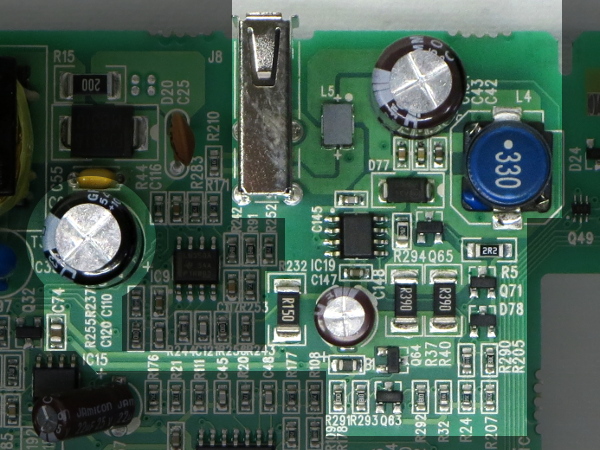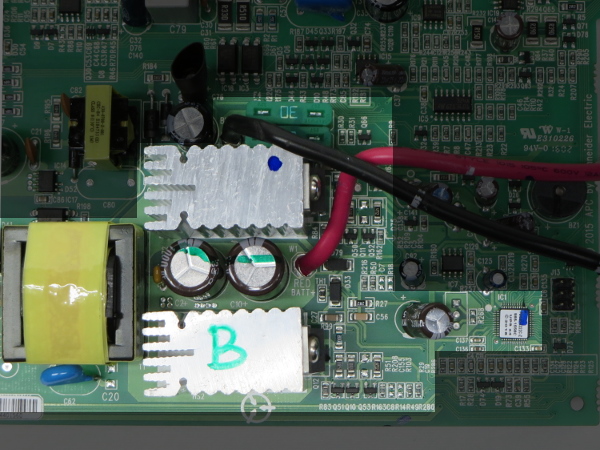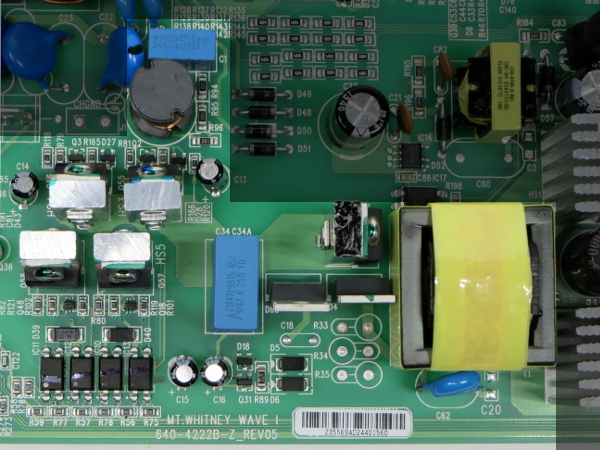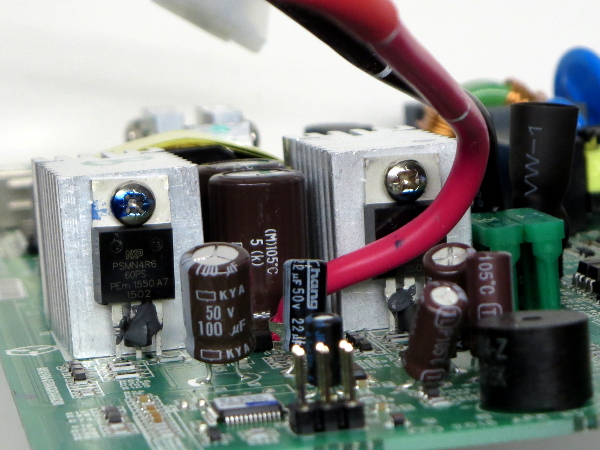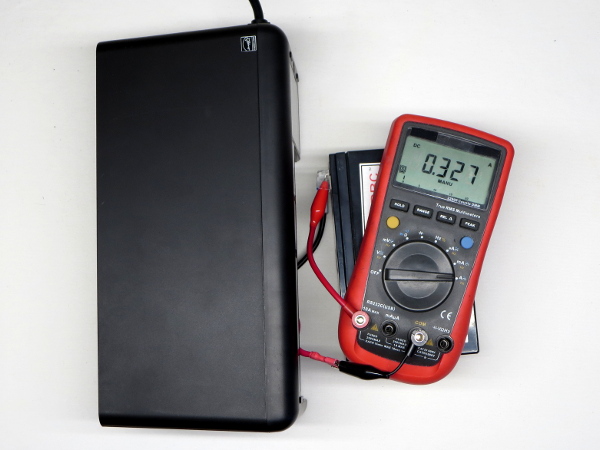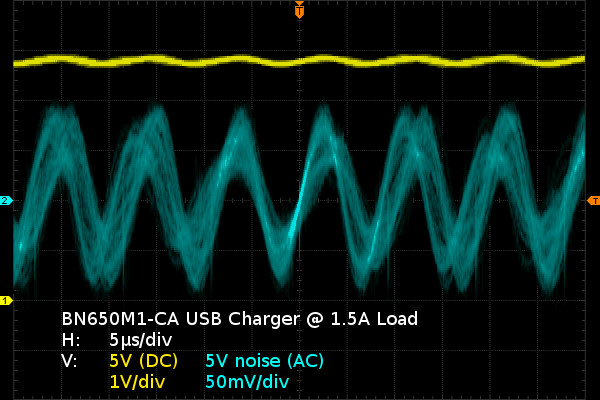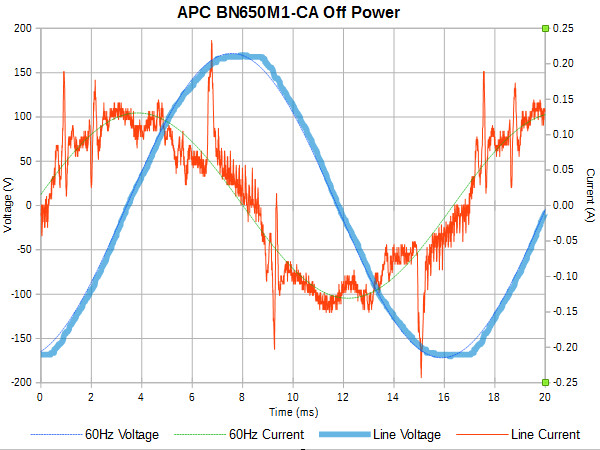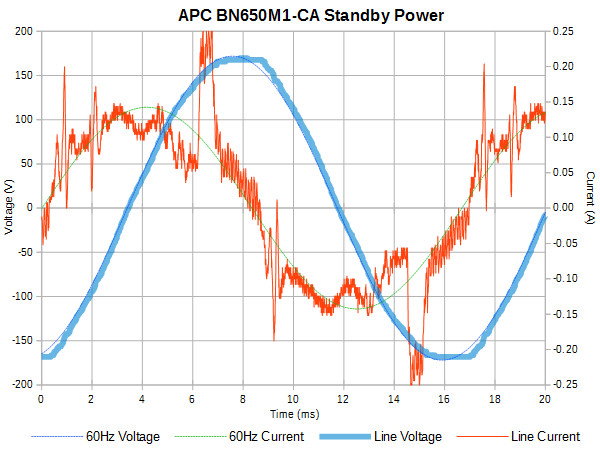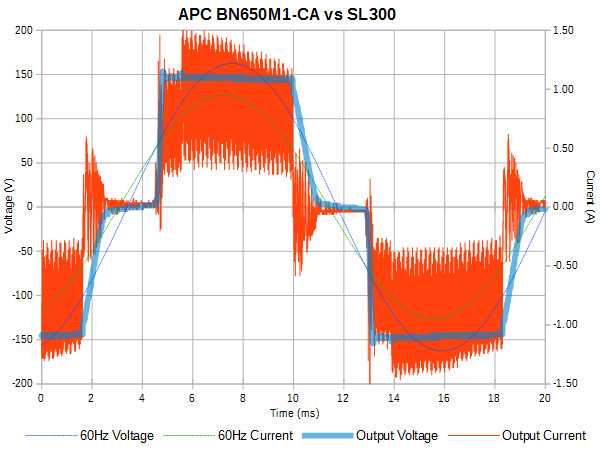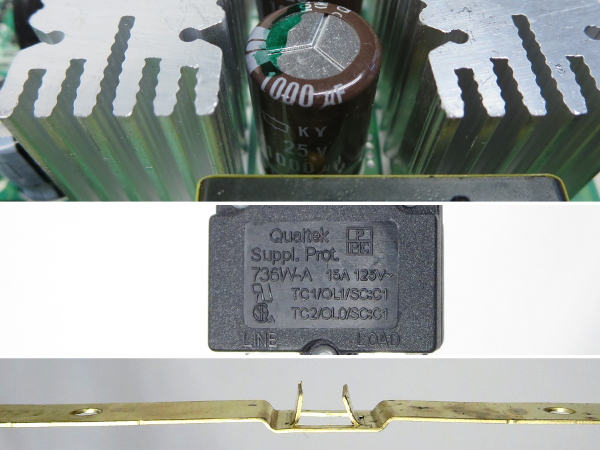APC BN650M1-CA UPS Tear-Down
USB Charging Port
Instead of using a modern high-efficiency switching regulator with built-in power switch and synchronous rectifier FETs, APC used what appears to be a $0.16 MC34063. Due to the 1.3 V cascaded base-emitter loss in its Darlington transistor and free-wheeling diode, efficiency can be expected to fall in the 80% to 85% range. Illinois has the local bypass and output filtering covered with 100 µF, 25 V and 330 µF, 25 V capacitors, respectively.
Following the traces going to the local bypass capacitor leads directly to the fat traces between the two supplies’ output capacitors, which show battery voltage when the UPS is off. Since the 34063 has neither an enable or shutdown pin, a control signal must have been hacked into the regulator’s circuit.
This looks like a lot of effort to fit a $0.16 key component instead of a $1 one.
Step-Up Primary
Following the current’s path from the positive battery wire, the electrons’ journey first passes through a pair of 25 V, 1000 µF Chemi-Con bypass capacitors, then through the step-up transformer’s center-tap, either of the two primary legs to their respective NXP PSMN4R660PS (60 V/100 A/4.6 mΩ) FETs’ drain, system ground through the FETs’ source terminal, and finally, battery negative through a pair of 30 A fuses. Were you expecting to see a top-brand capacitor in an inexpensive consumer UPS? I gave up on that a while ago. I see no switching controller, which means that the FETs must be software-controlled.
There is a third Chemi-Con capacitor to the right of the bottom heat sink. At a glance, it appears to bypass the relay’s power feed. That's a strange way to use a top-brand part.
Inverter Secondary
Stepping up from 125 VA to 650 VA requires a chunkier output bridge than the BGE90M’s surface-mount diodes. A pair of free-standing NXP BYV29-400 ultra-fast 400 V/9 A single diodes cover the low side, while a single common cathode TO-220 dual diode on an aluminum slab handles the high side. Rectified high voltage gets lightly filtered by a 470 nF, 250 V Epcos metal film capacitor before passing through the output bridge, an output inductor, and another 100 nF film capacitor. Similar to the primary side, the output switching is also under software control through four opto-isolators near the bottom-left corner.
From the battery terminals to the AC output, the inverter uses almost exactly the same circuit as the BGE90M, just beefier.
Get Tom's Hardware's best news and in-depth reviews, straight to your inbox.
Capacitor Potpourri
There are several capacitor brands mixed up here. In this shot alone, you can see a Chemi-Con capacitor in front of two large Chemi-Con capacitors between heat sinks. To its right, you also find one Chang and a cluster of three Jamicon capacitors.
How many capacitor brands are there? Let’s count: Chemi-Con, Illinois Capacitor, Epcos, Jamicon, Chang, Jianghai, OST, one logo I could not identify, and an unreadable brand on the X1Y1 circular capacitors at the input. That’s at least nine different companies, or six if we only count electrolytics.
No-Load Battery Draw
With the UPS turned off and disconnected from the wall, it draws 70 mA while shutting down and then drops to less than 1 mA. Turning the inverter on increases the battery draw to 330 mA, which is 65% more than the BGE90M. Some of that draw must be caused by higher parasitic capacitance and leakage in the souped-up HVDC converter components. The rest comes from the main supply being connected to the AC output. Unfortunately, I cannot measure this without cutting traces or removing multiple components to open the circuit.
While I was tapped into the battery circuit, I measured a peak charging current of about 1 A with a float voltage of 13.54 V where the battery trickle-charged at 10 mA.
USB Power Supply
How clean is the output? Approximately 200 mV peak-to-peak at 100 kHz on the USB connector. That's an order of magnitude worse than the BGE90’s 15 mVPP at 600 kHz. Surprisingly enough, though, there is no sign of switching noise. Under a 1.5 A load, the output also sags to 4.80 V measured at the port, while the output drops to 4.75 V at 2.06 A and goes into current-limiting mode at 2.2 A.
To find out whether the charging port is powered from the AC output or battery rail, I measured battery current while the port was providing 1.5 A and subtracted the 330 mA baseline to abstract away unrelated loads. The overall efficiency I calculated for the incremental power draw was 82%. This is right in the middle of my DC-DC conversion prediction, implying that the charging port is powered from the battery bus.
Off Power
Does the BN650M1-CA deliver on my expectation of sub-watt standby power? Between the 10 mA trickle-charge and 70 mA to run the electronics at 13.5 V battery voltage, we get approximately 1.08 W that the low-power supply needs to provide. We aren't going to see sub-watt from the input.
What did my spreadsheet say about input power? I got 12 VA courtesy of the dual 1 µF input capacitors, accounting for 11 VAR and 1.86 W of real input power for an efficiency of 58%. Leaving the unit plugged in but off when it's not needed will cost you in the neighborhood of two dollars annually. (1W ≈ $1/year at $0.11/kWh)
Standby Power
Standby power looks almost exactly the same, except that the peaks are wider, noisier, and of slightly higher magnitude. Apparent power goes up by 1.5 VA to 13.5 VA, as the real power more than doubles to 3.52 W. That's on par with the BGE90M and 0.7 W more than the BE550G.
With the battery still trickle-charging at 10 mA, we have an extra 1.44 W being consumed by the main power supply, the relay, USB power supply, and whatever other electronics kick in when the UPS is turned on.
BN650M1 vs. SL300
While the BN650’s current waveform is not quite as trippy as the EC350’s when powering an LED strip through my SL300 PSU, there is still a lot going on. Most notable is the steady oscillation near 50 kHz. Why? This could be related to the 100 nF HVDC capacitor and the output inductor: when the output bridge turns on in either direction, it connects the capacitor in series with the inductor and loads beyond it, forming a resonant LC circuit. If that output inductor happens to be in the neighborhood of 100 µH, then fC = 1/(2π√(LC)) yields approximately 50 kHz, and any noise near that frequency will cause the LC circuit to ring. When the inverter bridge turns off, the ringing dies down.
On the voltage side of things, the output registers 144 V in magnitude at 77% duty cycle, 115 VRMS with a THD of only 24%, courtesy of its soft slopes.
Some Steps Forward, As Many Steps Back
How does the BN650M1-CA stack up against its BGE90M-CA predecessor?
The good:
- Grounded outlets
- Two extra battery outlets
- Wiring fault indicator
- Buffed up input filtering and surge protection
- Slightly better battery
- Higher output rating
- USB port for monitoring and control
- Some top-tier capacitor brands in places that make sense
The bad:
- Breaker exceeds cord ratings
- One less USB charging outlet and 1 A-lower output current
The ugly:
- Dual supply design adds substantial cost and complexity for negligible benefit over a single always-on supply
- 65 percent higher baseline inverter battery current draw
- Major regression in the USB charger’s design and output quality
- Noisier output waveforms
- Flappy ground contact strip
Is the BN650M1-CA better? Unless you require one of its features, no. To me, it looks like a strange mix of premium design and compromises.
MORE: CyberPower EC350G Tear-Down
MORE: APC BGE90M-CA Tear-Down
MORE: APC BE550G Tear-Down
Follow us on Facebook, Google+, RSS, Twitter and YouTube.
-
firefyte I'm not sure if you found this spec sheet for the battery:Reply
http://www.csb-battery.com/upfiles/dow01320199159.pdf
I must comment, however, that I thoroughly enjoy these teardowns, as I had no idea that they can be THAT bad (or good). -
Daniel Sauvageau Reply
Yes, I did find that battery. Despite the model number differing by only one character, the HC-1228 is a much bigger battery (2.5kg vs 2.06kg, that's over 20% heavier) and if you look at the top, the terminal locations are completely different as well. Not comparable at all.18577258 said:I'm not sure if you found this spec sheet for the battery:
http://www.csb-battery.com/upfiles/dow01320199159.pdf
I must comment, however, that I thoroughly enjoy these teardowns, as I had no idea that they can be THAT bad (or good).
Glad you liked it.
-
nukemaster Glad you did this since you mentioned this unit in the comments on the other tear-down.Reply
Looks like the 75 watt unit(when on sale) is the better buy(as long as you do not need the ground and are power low light loads anyway). -
Daniel Sauvageau Reply
Yes, for small loads, the BGE90M is a pretty nice catch and I'm glad I picked two of them up at a ridiculously low price. I'll be swapping out my mother's BE550 with one of them the next time I drive there.18577935 said:Looks like the 75 watt unit(when on sale) is the better buy(as long as you do not need the ground and are power low light loads anyway).
When you buy a $100+ black box, aren't you at least the least bit curious about what's inside, what you are actually getting for your money? If you aren't, nobody is forcing you to read my tear-downs. Feel free to skip.18579009 said:What's the point of these teardowns? -
nukemaster Reply
Some people just like to take things apart and look inside. For others these types of articles are much safer.18579009 said:What's the point of these teardowns?
I am always interested in seeing inside of this type of stuff(any electronics for that matter.). -
nukemaster Reply
It is just just APC.18580671 said:But it seems like they only teardown apc's. Why only them?
Here are some Cyber Power units
http://www.tomshardware.com/picturestory/700-cyberpower-lx1500gu-fc-ups-tear-down.html
http://www.tomshardware.com/picturestory/731-cyberpower-ec350g-ups-tear-down.html#xtor=RSS-100
http://www.tomshardware.com/picturestory/721-cyberpower-cp1000pfclcd-ups-tear-down.html
I think it is limited to what the reviewer can buy(maybe locally as well) as well. -
Daniel Sauvageau Reply
Best Buy Canada stocks mostly CyberPower. Staples Canada stocks mainly APC. There are the odd Tripp-Lite units here and there, but after the SMART1000, I'm not going to try my luck with Tripp-Lite again unless I find heavily discounted units or receive a review sample.18580671 said:But it seems like they only teardown apc's. Why only them?
www.tomshardware.com/picturestory/708-tripp-lite-smart1000lcd-tear-down.html
On Amazon.ca, the SMART1000LCD is currently listed at $215 and there are some clearly superior UPS available around $160. I try to avoid buying UPS from Amazon due to their no-return/exchange/refund policy on UPS.
